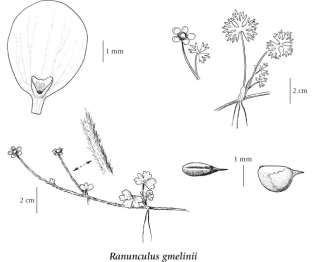Ranunculus gmelinii DC.
small yellow water-buttercup (Gmelin's buttercup)
Ranunculaceae (Buttercup family)
Introduction to Vascular Plants
small yellow water-buttercup (Gmelin's buttercup)
Ranunculaceae (Buttercup family)
Introduction to Vascular Plants
Species Information
General:
Aquatic or amphibious, perennial herb, rooting from nodes of lower stems, roots slender, fibrous; stems slender, simple to branched, floating or trailing, to 50 cm long, smooth or hairy, hollow.
Leaves:
Basal leaves absent; stem leaves alternate, kidney-shaped to circular, 3-lobed or -parted, 0.6-6.5 cm long, 1-9 cm wide, bases heart-shaped, the segments 1- to 3-times lobed to dissected, entire or round-toothed, tips rounded; submerged leaves sometimes deeply dissected into linear or thread-like segments; stalks to 5 cm long.
Flowers:
Inflorescence of solitary flowers from leaf axils, sometimes the terminal one a few-flowered cyme, the stalks 1-5 cm long; receptacle sparsely stiff-hairy; petals 5 or more, distinct, yellow, 3-7 (10) mm long, 2-5 mm wide, egg-shaped, nectary on upper surface, the nectary scale variable; sepals 4 or 5, spreading or bent back from base, early deciduous, 2-5 mm long, 2-4 mm wide, smooth or sparsely long-hairy; stamens 10-45; pistils 20-70.
Fruits:
Achenes, numerous in an egg- to globe-shaped head 3-8 mm long, 3-7 mm wide, the achenes egg-shaped, slightly flattened, 1-1.6 mm long, 1-1.2 mm wide, smooth, whitish-puffy over the lower 1/2 to 2/3 of the circumference; beaks persistent, lanceolate to thread-like, flattened, straight, 0.4-0.8 mm long.
Notes:
There are no reliable morphological differences for recognition of infraspecific taxa (Scott 1974). This species is closely related to R. flabellaris.
Illustration

If more than one illustration is available for a species (e.g., separate illustrations were provided for two subspecies) then links to the separate images will be provided below. Note that individual subspecies or varietal illustrations are not always available.
Illustration Source: The Illustrated Flora of British Columbia
Ecology
Ecological Framework for Ranunculus gmelinii
The table below shows the species-specific information calculated from
original data (BEC database) provided by the BC Ministry of Forests and Range.
(Updated August, 2013)
The table below shows the species-specific information calculated from
original data (BEC database) provided by the BC Ministry of Forests and Range.
(Updated August, 2013)
| Site Information |
Value / Class |
||
|
Avg |
Min |
Max |
|
| Elevation
(metres) |
1044 | 50 | 1740 |
| Slope
Gradient (%) |
2 | 0 | 60 |
|
Aspect (degrees) |
171 | 80 | 360 |
| Soil
Moisture Regime (SMR) [0 - very xeric; 4 - mesic; 8 - hydric] |
6 | 2 | 8 |
| Modal
Nutrient Regime
Class |
E | ||
| #
of field plots species was recorded in: |
38 | ||
| Modal
BEC Zone Class |
IDF | ||
|
All BEC Zones (# of stations/zone) species was recorded in |
BG(2), BWBS(1), ESSF(1), ICH(3), IDF(17), MS(3), SBPS(5), SBS(4), SWB(2) | ||
|
Source:
Klinkenberg 2013
|
|||
Habitat and Range
Ponds, shallow streams, shores and wet mud flats, ditches and drained beaver ponds in the lowland, steppe and montane zones; common throughout BC except rare along the coast; amphiberingian, N to AK, YT and NT, E to NF and S to MA, IA, MI, SD, UT, NM, NV and OR; E Asia.Status Information
Synonyms
Synonyms and Alternate Names:
Ranunculus gmelinii subsp. gmelinii
Ranunculus gmelinii subsp. purshii (Richardson) Hultén
Ranunculus gmelinii var. hookeri (D. Don) L.D. Benson
Ranunculus gmelinii var. limosus (Nutt.) H. Hara
Ranunculus gmelinii var. prolificus (Fernald) H. Hara
Ranunculus gmelinii var. purshii (Richardson) H. Hara
Ranunculus gmelinii var. terrestris (Ledeb.) L.D. Benson
Ranunculus gmelinii var. typicus L.D. Benson
Ranunculus hyperboreus var. tuquetilianus Polunin p.p.
Ranunculus limosus Nutt.
Ranunculus purshii Richardson